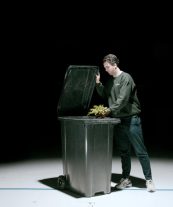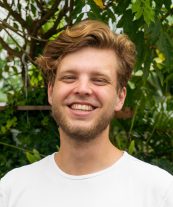COMMON GROUNDS - Bob Hendrikx x Auke Bleij
 1
1
 2
2
— ‘Nature can provide incredible solutions by itself’
Bob Hendrikx is a bio-designer who works with living organisms to develop sustainable products. In 2021, he was nominated for the Young Designer Award for his ‘living coffins’ and winning the Public Award. Bob spotlights Auke Bleij, who offers innovative solutions for urban greening through his start-up Respyre, including a moss-concrete wall.
Entrepreneurship
Bob: “Auke and I have a lot in common. We both come from TU Delft, focus on innovative ideas, and embarked on our entrepreneurial journeys at a young age. The core question for both of us is: ‘How can we make our world green again?’ Auke addresses that question literally. For me, designing means creating something tangible that can actually be used. Auke’s work is a perfect example of that.”
Auke: “Similarly, I often examine what Bob is doing. I feel he’s two years ahead of the rest of us, bulldozing through every challenge he encounters. His recent investment round with Loop Biotech was perfectly executed. Seeing that, I realize I need to step up my game.”
Bob: “Yes, that’s something you’ll also encounter in time. I too admire those who are a step ahead, like Julian Jagtenberg from Somnox (a ‘soft’ robot to sleep with, ed.) and Jouri Schoemaker from Pieter Pot (groceries in reusable jars, ed.). It’s like we’re all part of a larger chain. Does anyone follow in your footsteps yet, Auke?”
Auke: “Yes, lately I’ve been helping a few newcomers with their pitching.”
Bob: “That’s the beauty of it: we can help each other to move forward. I also learn things from Auke’s work. I just returned from the U.S. where I learned the importance of an Advisory Board for investors. Shortly after, I found out that you were already setting one up, and I thought: ‘Oh nice, they’re ahead of the curve!’.”
Living material
Bob: “Why does the future lie in working with living material? Bottom line is that we currently have a negative footprint, and my goal is to become a species with a positive footprint. This means collaborating with nature and keeping organisms alive. This opens up a new world of materials, where a tree is seen as a material and not just ‘wood.’ We’ve started to think from the organism’s perspective: What does a mushroom actually want? It’s a fundamental shift in design, with sustainability at its core.”
Auke: “Bob takes a slightly different approach. We humans have a very invasive attitude toward our environment, making numerous changes without fully considering the impact. This results in the creation of incredibly sterile buildings in cities, with extensive glass and stone, designed for minimal maintenance. However, once people begin to use those buildings, you realize the need for air conditioning, due to overheating, which then highlights the need for air filtration. Nature can offer incredibly effective solutions to these challenges. For example, moss is a pioneer species that’s ten times better than climate systems which require installation with significant artificial effort.”
New Aesthetic
Bob: “The type of mushroom we work with is generally white, but sometimes can develop a brown spot when conditions aren’t ideal for a time. We can now control the growth process so precisely that we can prevent this from happening. Which raises an intriguing ethical question for me: should we even guide this organism? Because then, as humans, we re-establish dominance. That’s why we offer two versions: one that’s perfectly white, and a ‘wild’ variant. By managing expectations in advance and advising people upfront that the product may differ from the photo, they’re usually okay with it. It’s all about managing expectations.”
Auke: “Managing those expectations is definitely a struggle. Many assume that moss-concrete functions like a paint that stays green indefinitely. So far, any discussion of the moss turning brown again has been suppressed. While architects like the product, contractors are often less enthusiastic. In a sense, we’ve chosen the more difficult path because we aim for widespread application, and not limit it to just a few high-end projects.”
Future
Auke: “Respyre’s mission is to help cities breathe again. Achieving that requires more than just moss-concrete, we need to incorporate nature in many locations. We want to extend to rooftops, and develop solutions for filtering out fine dust. My vision is to broaden Respyre’s role to establish us as an authority on scalable solutions for creating livable cities.”
Bob: “I strive to create a company that sets an example of how to grow products with a positive footprint. I envision Loop Biotech having factories all over the world, where local organisms are cultivated in harmony with nature. The ultimate goal is to restore contaminated soil using those organisms, transforming polluted areas into thriving forests.”
Evelien Reich has served as chair of the Young Designer jury of Dutch Design Awards for the past three years. This year, she interviews the Young Designers that DDA has selected from the archives, as well as the emerging talents they choose to spotlight. All twenty Young Designers, both past and present, will showcase their work at the 2024 DDA exhibition during Dutch Design Week in Eindhoven, taking place 19 to 27 October.
Discover the work of Bob Hendrikx and Auke Bleij and all the other Young Designers of the Past & Present in the DDA24 exhibition at Microlab Hall on Strijp-S, during Dutch Design Week. From 19 to 27 October 2024 in Eindhoven.